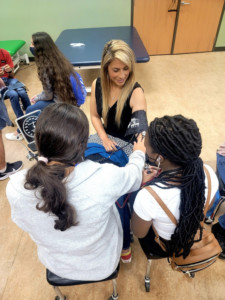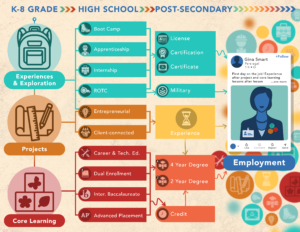A Turning Point. South Carolina Rural Schools Find Success.

The 2005 documentary, “Corridor of Shame: The Neglect of South Carolina’s Rural Schools” highlighted high poverty, low performing schools in the geographic region of South Carolina’s I-95 corridor. The region had spent decades being unable to provide effective education to their students. In 2010, Scott’s Branch High School was at an “At-Risk” rating on the SC Report card and had not met AYP for 3 years.
However, six years ago things started to shift when a partnership with New Tech Network (NTN) brought an opportunity to lift up education in the schools and communities. The effects of that partnership can be measured in a number of ways, one of which is student’s end-of-course test scores which were higher than the rest of the state and much higher than “schools with students like ours.”
Colleton County High and Scott’s Branch have been working to change the I-95 corridor region into a “Corridor of Innovation” instead of a “Corridor of Shame.” These two schools, with the help of a U.S. Department of Education Investing in Innovation (i3) grant, are improving education in their economically depressed communities by implementing new school models that bolster teacher and student capacity and create real-world learning experiences for students.
A Tale of Two Schools
Colleton County High School, located in Walterboro, S.C., through its partnership with NTN was able to launch Cougar New Tech, a career academy where 100% of the first senior class (2017) graduated.
Scott’s Branch High School found in Summerton, S.C., implemented NTN’s school model and shifted teaching practices to allow students to experience classroom learning that is relevant to students’ lives while preparing them for college and career opportunities.
As part of the NTN model, both schools are engaging in high-quality PBL. Students practice critical thinking, communication and creativity in order to solve problems. The relevant, real-world projects move students towards mastery and attainment of New Tech Network’s five learning outcomes which include: Knowledge & Thinking, Agency, Collaboration, Oral Communication and Written Communication.
NTN’s model and the flexibility of a PBL classroom allows teachers to teach across the curriculum and work together to help create deeper learning experiences for their students. Solving problems isn’t just cut and dry, it takes multiple skill sets for both students and teachers.
These two schools are the subject of a new mini-documentary and website called A Turning Point in South Carolina.
A Turning Point
The success of schools like Cougar New Tech and Scott’s Branch High school are a great example of how high quality, innovative learning can indeed happen anywhere. With the right supports, leadership and teaching teams, all students can have access to an engaging, meaningful education.
For more, see:
- Success in Rural, High-Poverty Public High Schools: Path to Equity?
- Three Key Factors Perpetuating the Socioeconomic Achievement Gap
- Preparing Students For Future Success with PBL and SEL
- El Paso and New Tech Network: District Transformation in High Gear
Stay in-the-know with all things EdTech and innovations in learning by signing up to receive the weekly Smart Update. This post includes mentions of a Getting Smart partner. For a full list of partners, affiliate organizations and all other disclosures, please see our Partner page.






Patti Shade
Happy to see student creativity as part of the solution. Developing creativity mindsets and skillsets changes children’s lives!